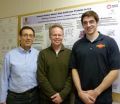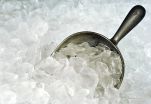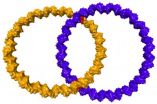(Press-News.org) A chance observation by a Queen's researcher might have ended a decades-old debate about the precise way antifreeze proteins (AFP) bind to the surface of ice crystals.
"We got a beautiful view of water bound to the ice-binding site on the protein," says Peter Davies, a professor in the Department of Biochemistry and a world leader in antifreeze protein research. "In a sense we got a lucky break."
AFPs are a class of proteins that bind to the surface of ice crystals and prevent further growth and recrystallization of ice. Fish, insects, bacteria and plants that live in sub-zero environments all rely on AFPs to survive. AFPs are also important to many industries, including ice cream and frozen yogurt production which relies on AFPs to control ice-crystal growth.
The implications of this finding reach far beyond creating low-fat, high water-content ice cream that maintains a rich, creamy texture. Having a clear idea of how AFPs bind to the surface of ice crystals would allow researchers and industries to engineer strong, versatile AFPs with countless commercial applications ranging from increasing the freeze tolerance of crops to enhancing the preservation of transplant organs and tissues.
While determining the crystal structure of an AFP from an Antarctic bacterium, biochemistry doctoral candidate Christopher Garnham was fortunate enough to see an exposed ice-binding site—a rare find in the field of AFP crystallography that Mr. Garnham studies.
The ice binding surface of an AFP contains both hydrophobic or 'water repelling' groups as well as hydrophilic or 'water loving' groups. Until now, the exact function of these counter-acting forces with respect to ice-binding was unknown.
While the presence of water repellent sites can appear counterintuitive on a protein that bonds with ice, Mr. Garnham and Dr. Davies are hypothesizing that the function of these water repellent sites is to force water molecules near the surface of the protein into an ice-like cage that mirrors the pattern of water molecules on the surface of the ice crystal. The water-loving sites on the protein's surface then anchor this ice-like cage to the protein via hydrogen bonds. Not until the ordered waters are anchored to the AFP is it able to bond to ice.
INFORMATION:
This research will be published today in the Proceedings of the National Academy of Sciences of the United States of America.
Finding may end a 30-year scientific debate
2011-04-12
ELSE PRESS RELEASES FROM THIS DATE:
Improve Your Foodservice Equipment Return on Investment With a Properly Conditioned Water Supply
2011-04-12
A new 600-pound cuber ice machine on average costs between $4K to $9K, while a 6-pan combi steam oven will cost about $12K to $35K. For a commercial semi-automatic espresso machine, a company has to spend between $8K to $20K. Even purchasing a 5-year old used machine, a company can expect to pay at least one-third of the new cost. With traffic only recently starting to increase after nearly a two year decline, operators have been understandably reluctant to spend on new equipment. As a result, foodservice equipment manufacturers saw a decline in sales of 15%-30%, or higher, ...
UNC study helps clarify link between high-fat diet and type 2 diabetes
2011-04-12
CHAPEL HILL, N.C. – A diet high in saturated fat is a key contributor to type 2 diabetes, a major health threat worldwide. Several decades ago scientists noticed that people with type 2 diabetes have overly active immune responses, leaving their bodies rife with inflammatory chemicals.
In addition, people who acquire the disease are typically obese and are resistant to insulin, the hormone that removes sugar from the blood and stores it as energy.
For years no one has known exactly how the three characteristics are related. But a handful of studies suggest that they ...
Penguins that shun ice still lose big from a warming climate
2011-04-12
WASHINGTON – Fluctuations in penguin populations in the Antarctic are linked more strongly to the availability of their primary food source than to changes in their habitats, according to a new study published online today in the Proceedings of the National Academy of Sciences. Funded in part by the Lenfest Ocean Program, this research indicates that species often considered likely "winners" of changing conditions, such as large-scale ice melting, may actually end up as the most vulnerable to the impacts of climate change.
The two penguin species of focus in the study ...
Effective pain management crucial to older adults' well-being
2011-04-12
Improved management of chronic pain can significantly reduce disability in older adults, according to the latest issue of the WHAT'S HOT newsletter from The Gerontological Society of America (GSA).
Based largely on presentation highlights from GSA's 63rd Annual Scientific Meeting in November 2010, the current WHAT'S HOT examines the impact of pain in older adults, strategies for managing pain and preserving function, and methods to improve the assessment and management of pain for residents in long-term care facilities, including those who have dementia. Support for this ...
MRI may contribute to early detection of Alzheimer's
2011-04-12
OAK BROOK, Ill. (April 11, 2011) – New research suggests that magnetic resonance imaging (MRI) could help detect Alzheimer's disease (AD) at an early stage, before irreversible damage has occurred, according to a new study published online and in the June print edition of Radiology.
With no known treatment to alter its course, AD exacts an enormous toll on society. The Alzheimer's Association estimates that 5.4 million Americans are living with the disease today, and the cumulative costs for care could top $20 trillion over the next four decades. As a result, there is ...
Stress wrecks intestinal bacteria, could keep immune system on idle
2011-04-12
COLUMBUS, Ohio – Stress not only sends the human immune system into overdrive – it can also wreak havoc on the trillions of bacteria that work and thrive inside our digestive system.
New research suggests that this may be important because those bacteria play a significant role in triggering the innate immune system to stay slightly active, and thereby prepared to quickly spring into action in the face of an infection.
But exactly how stress makes these changes in these bacteria still isn't quite clear, researchers say.
"Since graduate school, I've been interested ...
Media's focus on ideal body shape can boost women's body satisfaction -- for a while
2011-04-12
COLUMBUS, Ohio – When researchers had college-age women view magazines for five straight days that only included images of women with thin, idealized body types, something surprising happened: the readers' own body satisfaction improved.
But the boost in body image came with a catch. Those women whose body satisfaction improved the most also were more likely to report that they engaged in dieting behaviors such as skipping meals or cutting carbohydrates during the course of the study.
That suggests these women may be inspired by the images they view and become momentarily ...
Scientists identify a surprising new source of cancer stem cells
2011-04-12
FINDINGS: Certain differentiated cells in breast tissue can spontaneously convert to a stem-cell-like state, according to Whitehead Institute researchers. Until now, scientific dogma has stated that differentiation is a one-way path; once cells specialize, they cannot return to the flexible stem-cell state on their own. These findings hold true for normal mammary cells as well as for breast cancer cells.
RELEVANCE: These findings may redefine how researchers view cancer stem cells – the cells capable of seeding new tumors at primary and distant sites in the body. Therapies ...
The world's smallest wedding rings
2011-04-12
This release is available in German.
FRANKFURT. Creating artificial structures from DNA is the objective of DNA nanotechnology. This new discipline, which combines biology, physics, chemistry and material science makes use of the ability of the natural DNA-strains' capacity for self assembly. Smileys or small boxes, measuring only 10s of nanometers (10 one-billionths of a meter) were created from DNA in a drop of water. Prof Alexander Heckel and his doctoral student Thorsten Schmidt from the "Cluster of Excellence for Macromolecular Complexes" at Goethe University were ...
Tuberculosis strain spread by the fur trade reveals stealthy approach of epidemics
2011-04-12
Patience may be a virtue in a person, but in an infectious disease, it is insidious. Witness tuberculosis, which can lie dormant in a human host for decades before bursting forth into infection. TB's stealthy nature has made it difficult to decipher how it spreads, seriously hampering efforts to control it. The World Health Organization estimates that a third of the people on Earth are infected.
Now, a study led by Stanford scientists has provided new insights into the behavior of tuberculosis by tracing the travels of a particular strain of the disease that was unintentionally ...




